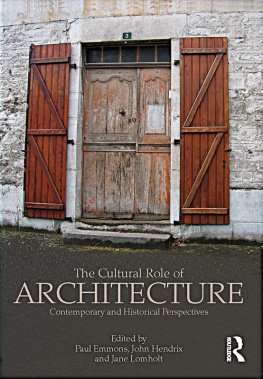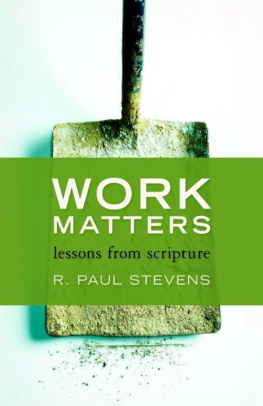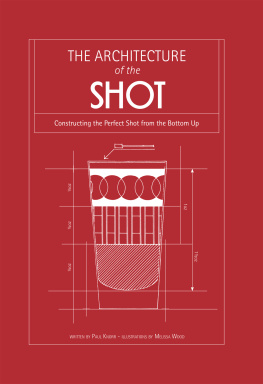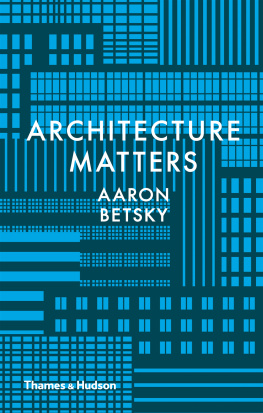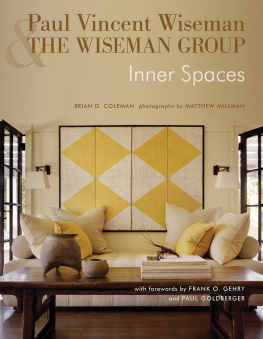Paul Goldberger - Why Architecture Matters
Here you can read online Paul Goldberger - Why Architecture Matters full text of the book (entire story) in english for free. Download pdf and epub, get meaning, cover and reviews about this ebook. year: 2009, publisher: Yale University Press, genre: Art. Description of the work, (preface) as well as reviews are available. Best literature library LitArk.com created for fans of good reading and offers a wide selection of genres:
Romance novel
Science fiction
Adventure
Detective
Science
History
Home and family
Prose
Art
Politics
Computer
Non-fiction
Religion
Business
Children
Humor
Choose a favorite category and find really read worthwhile books. Enjoy immersion in the world of imagination, feel the emotions of the characters or learn something new for yourself, make an fascinating discovery.

- Book:Why Architecture Matters
- Author:
- Publisher:Yale University Press
- Genre:
- Year:2009
- Rating:4 / 5
- Favourites:Add to favourites
- Your mark:
- 80
- 1
- 2
- 3
- 4
- 5
Why Architecture Matters: summary, description and annotation
We offer to read an annotation, description, summary or preface (depends on what the author of the book "Why Architecture Matters" wrote himself). If you haven't found the necessary information about the book — write in the comments, we will try to find it.
Why Architecture Matters — read online for free the complete book (whole text) full work
Below is the text of the book, divided by pages. System saving the place of the last page read, allows you to conveniently read the book "Why Architecture Matters" online for free, without having to search again every time where you left off. Put a bookmark, and you can go to the page where you finished reading at any time.
Font size:
Interval:
Bookmark:
why architecture matters
paul goldberger
yale university press
new haven and london
Copyright 2009 by Paul Goldberger. All rights reserved. This book may not be reproduced, in whole or in part, including illustrations, in any form (beyond that copying permitted by Sections 107 and 108 of the U.S. Copyright Law and except by reviewers for the public press), without written permission from the publishers.
Published with assistance from the Louis Stern Memorial Fund. Designed by Nancy Ovedovitz and set in Adobe Garamond type by Keystone Typesetting, Inc., Orwigsburg, Pennsylvania. Printed in the United States of America. Photo editor: Natalie Matutschovsky
Library of Congress Cataloging-in-Publication Data
Goldberger, Paul.
Why architecture matters / Paul Goldberger.
p. cm.
Includes bibliographical references and index.
ISBN 978-0-300-14430-7 (cloth : alk. paper)
1. ArchitecturePsychological aspects. 2. Architecture and
society. I. Title.
NA2540.G63 2009
720.103dc22 2009011071
A catalogue record for this book is available from the British Library.
This paper meets the requirements of ANSI/NISO
Z39.48-1992 (Permanence of Paper).
10 9 8 7 6 5 4 3 2 1
The City Observed, New York: An Architectural Guide to Manhattan
The Skyscraper
On the Rise: Architecture and Design in a Post-modern Age
Houses of the Hamptons
Manhattan Unfurled (with Matteo Pericoli)
The World Trade Center Remembered
Up from Zero: Politics, Architecture, and the Rebuilding of New York
Beyond the Dunes (with Jake Rajs)
For Susan, Adam, Ben, and Alex;
Delphine, Thibeaux, and Josephine
and for Vincent Scully
We could not live without architecture, but that is not why it matters. The purpose of this book is to explain what buildings do beyond keeping us out of the rain. Architecture may be able to stake a claim to being necessary to our lives in a way that poetry and literature and painting cannot, but the fact that buildings give us shelter is not the answer to the question posed by the title. If it were as simple as that, there would be nothing left to say.
Architecture begins to matter when it goes beyond protecting us from the elements, when it begins to say something about the worldwhen it begins to take on the qualities of art. You could say that architecture is what happens when people build with an awareness that they are doing something that reaches at least a little bit beyond the practical. It may be as tiny a gesture as painting the front door of a house red or as grand an undertaking as creating the rose window of a cathedral. It can be as casual as a sliver of decorative molding around a window or as carefully wrought as the ceiling of a Baroque church. A clapboard farmhouse with a columned porch is architecture; so is a house by Frank Lloyd Wright in which every inch of every wall, every window, and every door is part of an elaborately considered composition. Wright liked to say that architecture began when he started building his sprawling modern houses on the American prairie; Mies van der Rohe said, more poetically and also more modestly, that the origin of architecture was in the first time two bricks were put together well.
The making of architecture is intimately connected to the knowledge that buildings instill within us emotional reactions. They can make us feel and they can also make us think. Architecture begins to matter when it brings delight and sadness and perplexity and awe along with a roof over our heads. It matters when it creates serenity or exhilaration, and it matters just as much, I have to say, when it inspires anxiety, hostility, or fear. Buildings can do all of these things, and more. They represent social ideals; they are political statements; they are cultural icons. Architecture is surely our greatest physical symbol of the idea of community, our surest way to express in concrete form our belief in the notion of common ground. The way a community builds tells you, sometimes, all you need to know about its values: just to look at Radburn, New Jersey, will tell you that it is a suburb built to control the automobile, in the same way that it does not take long to figure out that Positano and the rest of the Amalfi Coast in Italy were built to connect to the sea. You can understand the difference between, say, the leafy precincts of Greenwich, Connecticut, and the suburban tracts of Levittown, Long Island, more easily, I suspect, by comparing Greenwichs estates to Levittowns houses than you could by looking at the residents of each community. The people can mislead you more easily than their architecture can.
Buildings also stand as evidence of the power of memory. Who has not returned after many years to a house, a school, a hotel, or some other place in which meaningful events in your life occurred and not found that the buildings themselves unleashed a sense of the past too strong to ignore? Architectural historian Vincent Scully has said that architecture is a conversation between the generations, carried out across time, and while you could say that this is true of all forms of art and culture, in architecture the conversation is the most conspicuous, the most obvious, the most impossible to tune out. We may not all participate in the conversation, but we all have to listen to it. For that reason alone, architecture matters: because it is all around us, and what is all around us has to have an effect on us. That effect may be subtle and barely noticeable, or it may shake us to the core, but it will never fail to be there.
Because architecture is there, presenting itself to us even when we do not seek it out or even choose to be conscious of it, it makes sense to think about it in slightly different terms from the way in which we might discuss, say, Baroque music or Renaissance sculpture, which is to say that it makes sense to consider it not only in terms of great masterpieces but also in terms of everyday experience. Architecture is a part of daily life for everyone, whether or not they want it to be. You may visit Chartres Cathedral as a conscious act of intention, just as you might elect to read Madame Bovary or decide to hear a performance of Beethovens late quartets, but you live your life within and around and beside dozens of other buildings, almost none of which you have chosen to be with. Some of them may be masterpieces and some of them may be the architectural equivalent of dime-store novels or elevator music. It is perfectly reasonable to talk about the meaning of literature without talking about Danielle Steel, but can you grapple with the impact of architecture without looking at Main Street?
I tend to think not, which is why the pages that follow will deal to a great extent with the everyday experience of looking at buildings, which is, for most people, a major reasonsometimes the only reasonthat architecture matters. Masterpieces are no less important for this, and they will get plenty of attention here. It is not wrong to say that the greatest buildings provide the greatest moments of architectural experience. They certainly have for me. But I prefer to see architecture not as a sequential story of masterworks, a saga beginning with the Pyramids and the Parthenon and extending through Chartres and the Taj Mahal and the Duomo and the Laurentian Library and St. Pauls Cathedral, and then on to the work of Louis Sullivan and Wright and Le Corbusier and Mies van der Rohe, but as a continuum of cultural expression. Architecture is the will of an epoch translated into space, Mies said. Buildings tell us what we are and what we want to be, and sometimes it is the average ones that tell us the most.
Next pageFont size:
Interval:
Bookmark:
Similar books «Why Architecture Matters»
Look at similar books to Why Architecture Matters. We have selected literature similar in name and meaning in the hope of providing readers with more options to find new, interesting, not yet read works.
Discussion, reviews of the book Why Architecture Matters and just readers' own opinions. Leave your comments, write what you think about the work, its meaning or the main characters. Specify what exactly you liked and what you didn't like, and why you think so.



